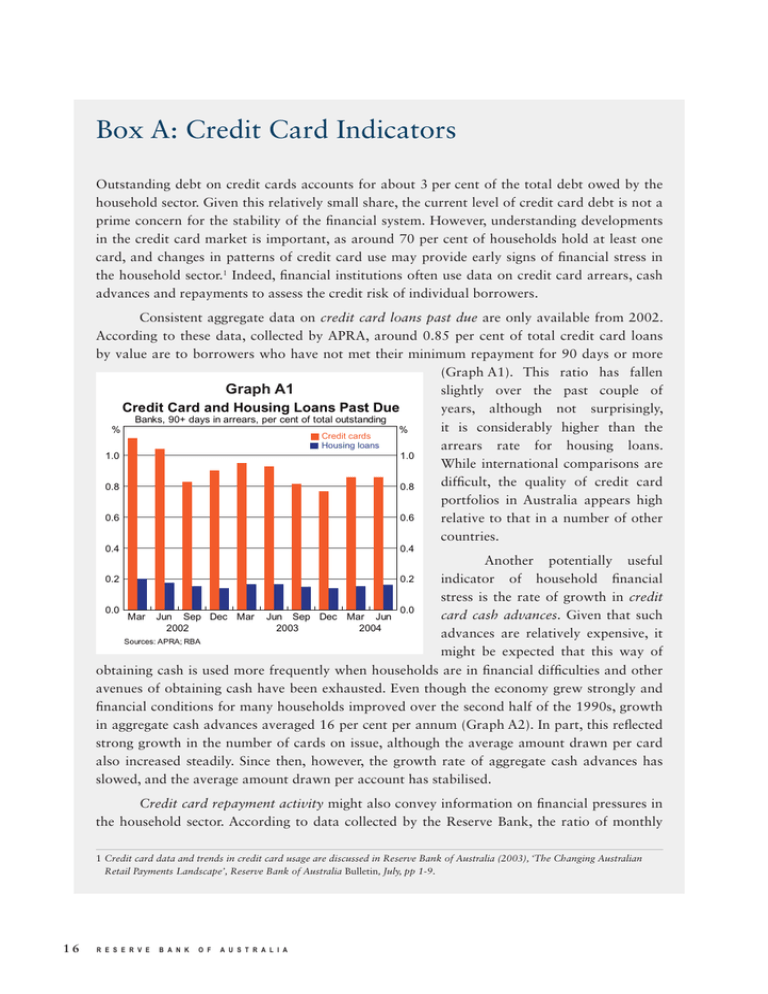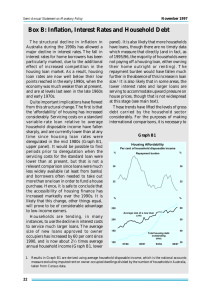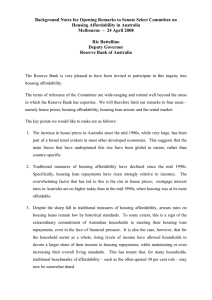Box A: Credit Card Indicators
advertisement

Box A: Credit Card Indicators Outstanding debt on credit cards accounts for about 3 per cent of the total debt owed by the household sector. Given this relatively small share, the current level of credit card debt is not a prime concern for the stability of the financial system. However, understanding developments in the credit card market is important, as around 70 per cent of households hold at least one card, and changes in patterns of credit card use may provide early signs of financial stress in the household sector.1 Indeed, financial institutions often use data on credit card arrears, cash advances and repayments to assess the credit risk of individual borrowers. Consistent aggregate data on credit card loans past due are only available from 2002. According to these data, collected by APRA, around 0.85 per cent of total credit card loans by value are to borrowers who have not met their minimum repayment for 90 days or more (Graph A1). This ratio has fallen Graph A1 slightly over the past couple of Credit Card and Housing Loans Past Due years, although not surprisingly, Banks, 90+ days in arrears, per cent of total outstanding it is considerably higher than the % % Credit cards Housing loans arrears rate for housing loans. 1.0 1.0 While international comparisons are difficult, the quality of credit card 0.8 0.8 portfolios in Australia appears high 0.6 0.6 relative to that in a number of other countries. 0.4 0.4 Another potentially useful indicator of household financial stress is the rate of growth in credit 0.0 0.0 card cash advances. Given that such Mar Jun Sep Dec Mar Jun Sep Dec Mar Jun 2002 2003 2004 advances are relatively expensive, it Sources: APRA; RBA might be expected that this way of obtaining cash is used more frequently when households are in financial difficulties and other avenues of obtaining cash have been exhausted. Even though the economy grew strongly and financial conditions for many households improved over the second half of the 1990s, growth in aggregate cash advances averaged 16 per cent per annum (Graph A2). In part, this reflected strong growth in the number of cards on issue, although the average amount drawn per card also increased steadily. Since then, however, the growth rate of aggregate cash advances has slowed, and the average amount drawn per account has stabilised. 0.2 0.2 Credit card repayment activity might also convey information on financial pressures in the household sector. According to data collected by the Reserve Bank, the ratio of monthly 1 Credit card data and trends in credit card usage are discussed in Reserve Bank of Australia (2003), ‘The Changing Australian Retail Payments Landscape’, Reserve Bank of Australia Bulletin, July, pp 1-9. 16 R E S E R V E B A N K O F A U S T R A L I A repayments to outstanding balances increased steadily over the second half of the 1990s, although this ratio has levelled off over the past few years (Graph A3). The increase in the 1990s is partly explained by the growth of credit cards as a payment instrument, although the generally favourable financial conditions facing the household sector may have also played a role. Another measure of repayment activity is provided by the proportion of cardholders that usually pay off at least one credit card each month. According to survey data collected by Roy Morgan Research Australia, this proportion also trended higher over the 1990s, before levelling off in recent years. Overall, while structural change in the credit card market over the past decade complicates analysis of the various indicators, the available data are consistent with low levels of financial stress in the Australian household sector. Graph A2 Credit Card Cash Advances % % Year-ended growth in aggregate cash advances* 30 30 15 15 0 0 $ $ Average cash advances per account* 100 100 80 80 60 60 40 40 1994 1996 1998 2000 2002 2004 * Three-month moving average; series break at January 2002 due to coverage changes Source: RBA Graph A3 Credit Card Repayment Activity % % Monthly repayments 50 50 45 45 40 Share of outstanding balances Trend 35 35 % % Those who usually pay off credit card* 78 78 76 76 Proportion of credit card holders 74 74 (two-quarter moving average) 72 70 40 72 1994 1996 1998 2000 2002 2004 70 * Those aged 18+ who usually pay off at least one major credit card each month Sources: RBA; Roy Morgan Research Australia F I N A N C I A L S T A B I L I T Y R E V I E W | S E P T E M B E R 2 0 0 4 17



